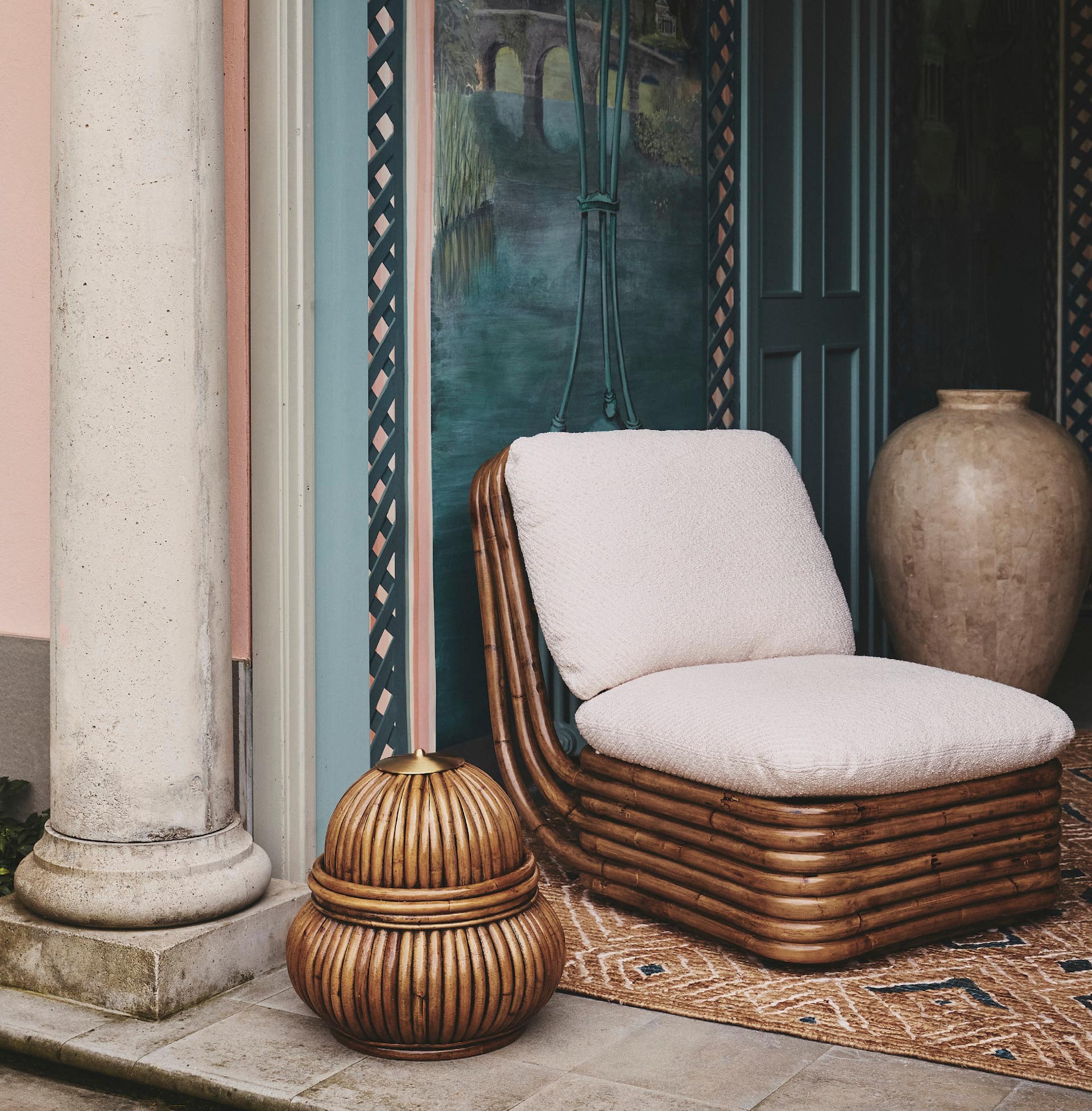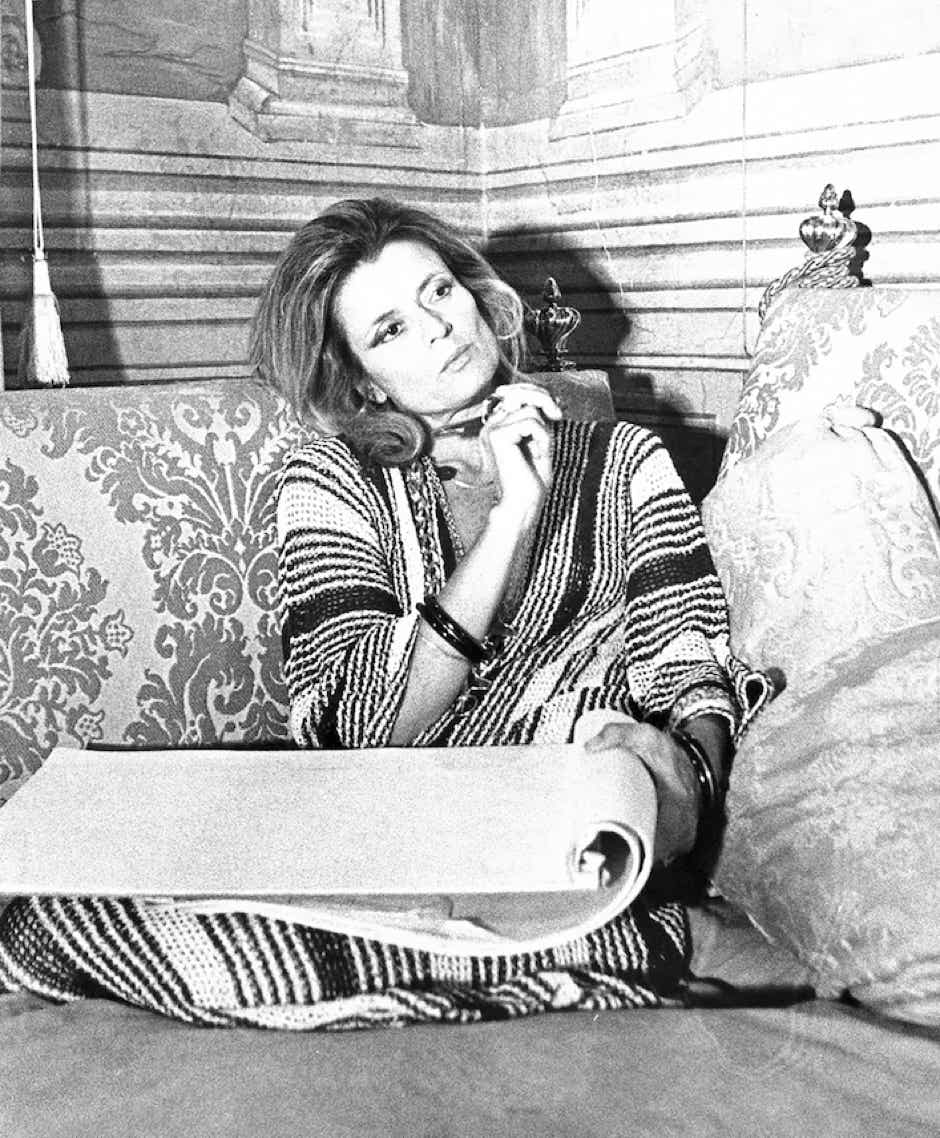
The Bohemian 72 collection was never designed by Gabriella Crespi to be mass-produced: its exclusive pieces were made for the private homes of a few privileged, wealthy clients. Fifty years later, Gubi is finally making them accessible to a wider audience to celebrate the centenary of their creator.
Both relaxed and refined, the Bohemian 72 collection marks a peak in the bohemian jet-set lifestyle that characterized Gabriella Crespi's very international clientele. Made of rattan, it embodies her ideal of life where interior and exterior spaces should merge and that Crespi refused to separate: banishing the curtains, she insisted on the continuity of the natural flows of air and light.
Gabriella Crespi: “I wanted to create the house of the sun. I couldn't resist doing it with rattan and bamboo, materials that I really like and which combine strength and flexibility, the warmth of soft tones and the ability to be penetrated by light. Very long rays give a sense of infinity and indeterminacy much like thickets of cane rising skyward do in nature. »
The making of the Bohemian 72 collection elements requires a high level of craftsmanship, as the rattan canes must be steamed and bent by hand around a die, specially designed to the dimensions of the furniture. Canes and bands are stained and finished with a gloss coating.
The seats are equipped with a generously padded cushion, which follows the contour of the structure. Outdoor fabrics are available. Without being entirely outdoor, the elements can be installed without damage outside if the weather is not too bad.
Chair 105 x 70 x H90 cm Sofa 210 x 105 x H90 cm Seat height 43 cm Ottoman 70 x 70 x H43 cm
Lamp Ø45 x H45 cm Light source E27 Cable 200 cm
Materials rattan, foam, wadding, brass detail (lamp)
Ottoman
Chair
Sofa
Lamp
Gubi and Dedar have specifically developed this fabric to match the « very Crispi » idea of living, allowing the furniture to fluidly stay inside or outside the house.
Gubi and Dedar have specifically developed this fabric to match the «very Crispi» idea of living, allowing the furniture to fluidly stay inside or outside the house.
Gubi and Dedar have specifically developed this fabric to match the «very Crispi» idea of living, allowing the furniture to fluidly stay inside or outside the house.
Gubi and Dedar have specifically developed this fabric to match the «very Crispi» idea of living, allowing the furniture to fluidly stay inside or outside the house.





Gabriella Crespi

Italian artist and designer Gabriella Crespi (1922-2017) attracted a devoted following with her repertoire of over two thousand pieces, ranging from furniture to jewelry and sculptures, paired with an eclectic style that embraced both the whimsical organic and the formally geometric.
Born near Milan, Italy, Crespi spent her childhood in Tuscany and the Scottish Hebrides, before returning to Italy to study art at the Brera Academy in Milan. In 1944, she became one of the few women to enroll in the faculty of architecture of the Politecnico di Milano.
The collection that ignited her design career was the Small Lune Collection, a series of moon-shaped steel sculptures, which caught the attention of Maison Dior. The crescent motif would reappear in his sculptures and lighting designs throughout the 1960s and 1970s through its appeal to symbolism and spirituality.
She often cited the Swiss architect and designer Charles-Édouard "Le Corbusier" Jeanneret and the American architect Frank Lloyd Wright among her influences, although her work was less systematic and her approach more akin to that of a workshop in the Renaissance.
Crespi first begins by developing sketches and wax models for high-end collections of furniture, lighting and decorative accessories in her home, then brings them to life in limited quantities through her network of Italian skilled artisans, using noble materials and traditional handmade methods.
In the 1960s, Crespi had partnered with Maison Dior to design striking home furnishings. Channeling the spirit of mid-century design and exploring the flexibility of modern furniture, her designs from this era were notable for their clean forms and sumptuous material finishes. Her aesthetic was characterized by dualities, combining modernist functionality with an eye for the baroque, and oscillating between clean lines and sensuous curves.
The 1970s saw her conceive and develop a series of iconic designs, including her Z Desk and Z Bar (1972-1975); the Cabinet Menhir (1978); and the Ara table (1979), but above all the elegant Plurimo series (1970-1982), a collection of metamorphic furniture which she created in collaboration with her daughter Elisabetta - later additions to Plurimo include the Ellisse table (1976) and the Yang Yin Office (1979). These concept pieces experimented with changing shapes for multiple uses, incorporating retractable or multi-functional elements – for example, the split top of the gold coffee table pivots to serve drinks.
Her love of contrasts is also evident in her choice of materials. Although Crespi was drawn to woods and precious metals such as bronze and brass, she also appreciated the humility and versatility of rattan and bamboo. This affection perfectly matched the tastes of the high society of the 1970s, a period when rattan represented the height of sophistication. The many rattan furniture pieces produced by Crespi include the much admired Rising Sun Collection (1973-1975), which included chairs, a dining table, trays, screens, a cradle and the mushroom-shaped Fungo lamp (1973) .
Crespi effortlessly carved out a place for herself among European royalty and the Hollywood jet set, counting Audrey Hepburn, Gianni Versace and Hubert de Givenchy among her clients and social circle. Her unmistakable glamor and spontaneous sense of style made her a muse for fashion designer Valentino.
After decades of success, Crespi gave up her career and lifestyle at the height of her glory in 1987 to follow guru Shri Muniraji on a spiritual journey to the Himalayas. She stayed in India for almost 20 years and documented her experiences in the book "Ricerca di Infinito", published in 2007 when she returned to Milan after an accident prevented her from continuing her journey.
Adopting a slower pace and more spiritual approach, Crespi resumed her career as a designer during the last decade of her life. For example, she collaborated with Stella McCartney on a limited edition jewelry collection for charity in 2008. In 2011, a tribute to her artistic life took place in Milan. The anthology "The Sign and the Spirit" covered all areas of Crespi's creativity through her unique works of art, still jealously guarded among passionate collectors.
Crespi created an archive of her works in 2012, contributed to a retrospective exhibition with Sergio Rossi in 2013 and designed New Bronze Age - a series of new limited edition models presented by Galleria Rita Fancsaly in 2015. The Wave Desk was her final design, before her death in Milan on 14 February 2017.